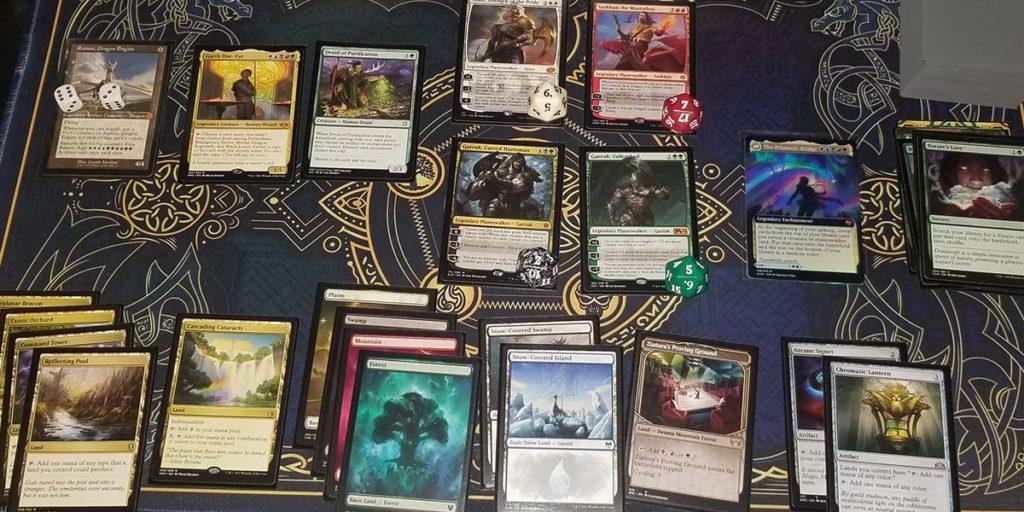
Are you wanting to know how to build a Commander deck with the assistance of a Commander deck building template? A lot of folks, especially newer players wonder how to build a Commander deck. What is considered a good amount of lands? How about removal? And not just creature removal… What about card draw? Ramp? All of these types of strategies go in to building a Commander deck.
With the help of a Commander deck building template, it is pretty easy to learn how to build a Commander deck. This is a full guide to help MTG players learn how to build a Commander deck that is fully functioning and reliable. Follow this guide, and download the free Commander deck building template to learn how many lands to put in your Commander decks, how many ramp spells to run, how much removal you need and much more! Let’s dive in.
Table of Contents
This post contains affiliate links, which means I may receive a small commission, at zero cost to you, if you make a purchase through a link.
Commander Deck Building Template
This entire article will go over, in depth, the topics covered in this Commander deck building template. The template is comprised of categories for strategies to include in your deck. As you follow this guide, you will learn that a specific card may fall into multiple categories. Not only is that okay, but that is recommended as having a card with multiple purposes ultimately gives you more flexibility to react to certain scenarios and bring synergy to your deck’s theme!
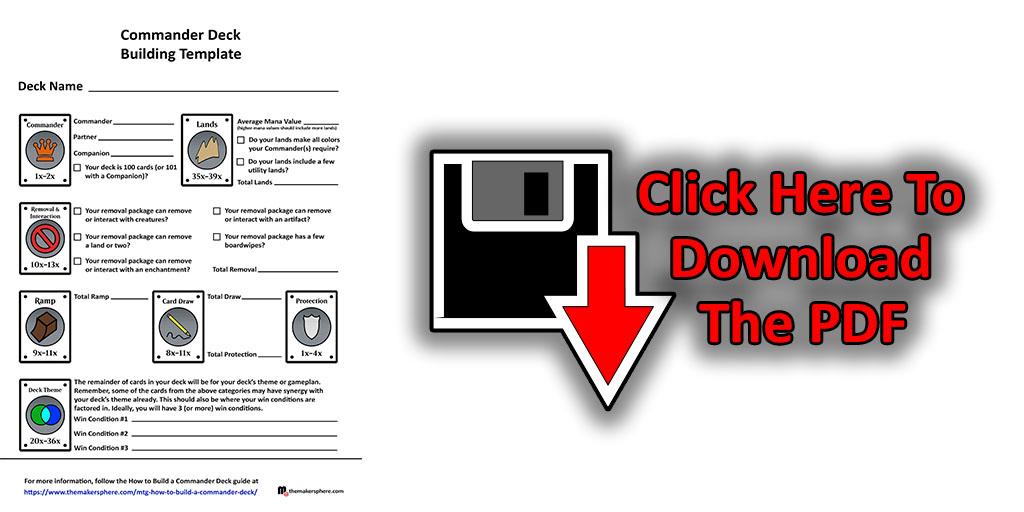
How to Build a Commander Deck
Using the free Commander Deck Building Template downloaded above, we will discuss each section in depth. Please be advised, this Commander deck building template is mainly a starting point and some guidelines. Do not feel like you must follow it word for word.
Deviate from it if you feel like your deck needs fewer or more lands, for example. Or if your deck is looking to draw more cards, by all means, add more card draw. This template and guide are tools to help with the initial deck construction process. The topics covered below are:
- Having Ramp in your deck
- Constructing a solid Removal package
- Multiple sources of Card Draw
- Ensuring your deck has plenty of Lands
- Adding Protection to your deck
- Examples of Synergy and Deck Themes
Learning How to Build a Commander Deck Involves Having Lots of RAMP
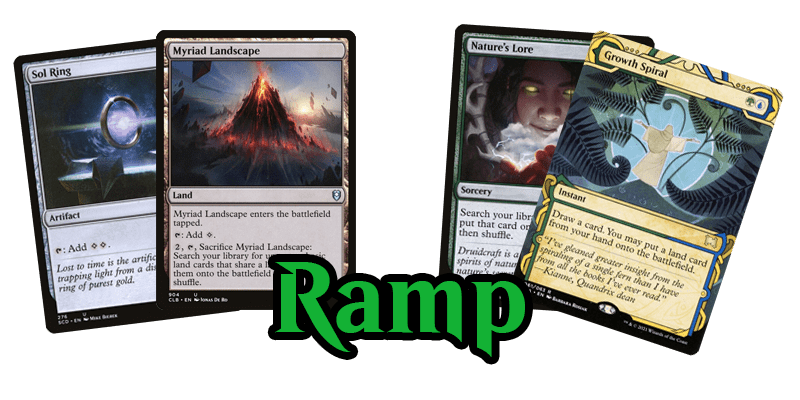
One of the most important aspects of learning how to build a Commander deck is including ample ramp. Now, in my opinion, if you are playing Green, you should build a bit differently, even if you are running 5 colors. Check out the Best Green Ramp Spells guide to see what I’m talking about. With that being said, there are many different forms of ramp.
- Artifact ramp: Sol Ring, Arcane Signet, Mind Stone, etc.
- Creature ramp: Solemn Simulacrum, Sakura-Tribe Elder, Wood Elves, etc.
- Instant ramp: Growth Spiral, Harrow, Omen of the Hunt, etc,
- Sorcery ramp: Into the North, Cultivate, Nature’s Lore, etc.
- Enchantment ramp: Fertile Ground, Wild Growth, Wolfwillow Haven, etc.
- Lands that ramp: Myriad Landscape, Krosan Verge, Blighted Woodland, etc.
If you are not playing green, you will probably rely on a lot of artifact ramp such as the Talismans, Signets, Mind Stone, Commander’s Sphere, Thought Vessel, Everflowing Chalice, etc. On top of that, you may also want to include some creatures that ramp such as Solemn Simulacrum, Burnished Hart, Palladium Myr, etc.
Then there are single instance ramp spells such as Jeweled Lotus, Irencrag Feat, Dark Ritual, Mana Drain, Culling Ritual, etc. These forms of ramp are usually one-and-done. But, in the right decks and played at the right time, these effects can be backbreaking for you opponents and extremely advantageous to you.
Multipurpose Ramp
As per the Commander Deck Building Template, try to include around 9x – 11x pieces of ramp in your deck. Within that, I like for some of my ramp to also serve multiple different purposes.
Picture this hypothetical scenario, you may want to have Culling Ritual in a deck over a Skyshroud Claim. The Skyshroud Claim gives you two lands moving forward, but the Culling Ritual is both removal and ramp at the same time.
Depending on the number of permanents 2 CMC or lower, you could be looking at 10+ extra mana for the turn that you cast it. Plus it will remove your opponent’s ramp like their Sol Rings and other cheap manarocks boosting you even further ahead.
Knowing How to Build a Commander Deck Will Require All Kinds of Removal
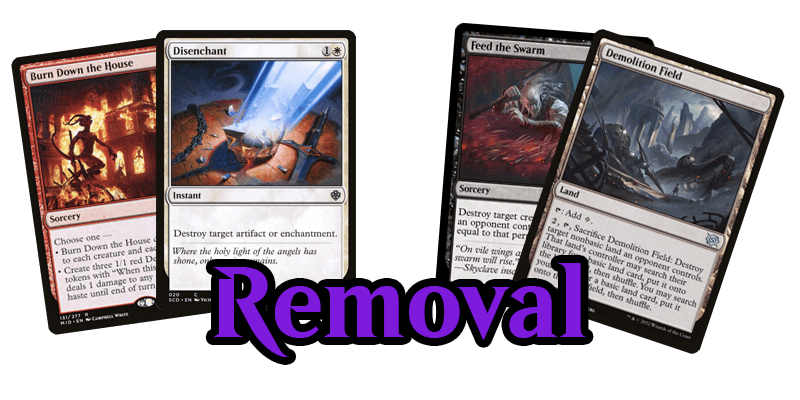
Something I see a lot when browsing Magic/Commander topics is folks talking about the lack of removal, or interaction from their opponents. Removal is import; you want to be able to respond to your opponents threats. And threats aren’t just creatures either. One thing that really helped me when I was a new player was to stop thinking of removal as only boardwipes and creature removal such as Infernal Grasp.
Different Kinds of Removal
You need to think about Planeswalkers, lands, artifacts and enchantments too. When I make a deck, I want the ability to get rid of anything problematic, no matter what type of threat it is. For example, how would you deal with a powerful land an opponent has played?
What I would do is run a copy of Demolition Field or Strip Mine to be able to stop the threat. Running either of those lands would count as both a piece of removal and as a land itself, serving double-purpose.
Another piece of removal some folks may not realize are counter spells. So if I am playing a mono blue deck, I don’t have the best conventional removal available to me but I do have countermagic available to me. If you counter a problematic permanent before it enters the battlefield, it ends up in the graveyard same as if it had entered the battlefield and you removed it.
You could also count redirect spells as removal. But, most of the times these will redirect Instants, Sorceries, and/or Abilities as opposed to permanents. Red has access to a good amount of cards with this effect.
- Counter spells to remove the treat before it ever has a chance to resolve
- Artifact removal: Vandalblast, Gemrazer, Abrade, Disenchant, etc.
- Redirect spells: Redirect, Wyll’s Reversal, Bolt Bend, Chef’s Kiss, etc.
- Targeted removal: Swords to Plowshares, Pongify, Beast Within, etc.
- Sacrifice pieces: Doom Foretold, Invoke Despair, Tragic Arrogance, etc.
- Boardwipes: Doomskar, Extinction Event, Storm’s Wrath, etc.
- Mass bounce: Cyclonic Rift, Whelming Wave, Slinn Voda, the Rising Deep, etc.
- Burn spells: Lightning Bolt, Shock, Crackle with Power, etc.
- Fight spells: Khalni Ambush, Primal Might, Tail Swipe, etc.
- Land removal: Demolition Field, Strip Mine, Armageddon, etc. – maybe don’t run Armageddon though lol
Multipurpose Removal
When I build a deck, I try to follow the Commander Deck Building Template by including 10x – 13x pieces of removal with the ability to handle all types of permanents, not just creatures. A lot of the removal I use would be what I consider multipurpose.
I really like the MDFC cards such as Ondu Inversion, Shatterskull Smashing, Hagra Mauling, etc. In the early part of games, these can be lands. In the later parts of games, when you have enough lands or if you are just flooding, these become spells you can cast and are not just dead in your hand.
Along those lines are choice spells which give you a lot of flexibility. Spells such as Austere Command, Abrade, Sublime Epiphany, etc. give you choices to use depending on the given scenario. Some of these types of spells only let you choose one option, some you can choose a few options, and others let you choose as many options as you’d like.
These types of cards give you more flexibility to dealing with threats at the cost of some stability. Also, these types of cards (usually) let you remove other permanent types besides creatures as well.
Take Infernal Grasp and Sheoldred’s Edict, for example. They both have their positives and their negatives. Infernal Grasp lets you choose which creature to remove, but you can’t remove a Planeswalker and it only removes one threat.
Sheoldred’s Edict, on the other hand, lets you hit each opponent and you can choose token/non token creature or Planeswalker. The downside is the opponent chooses which permanent they sacrifice of the chosen type, not you. Sheoldred’s Edict gives you more flexibility but less stability whereas Infernal Grasp gives you more stability but no flexibility.
As the Commander Deck Building Template Suggests, Find Ways To Draw Cards
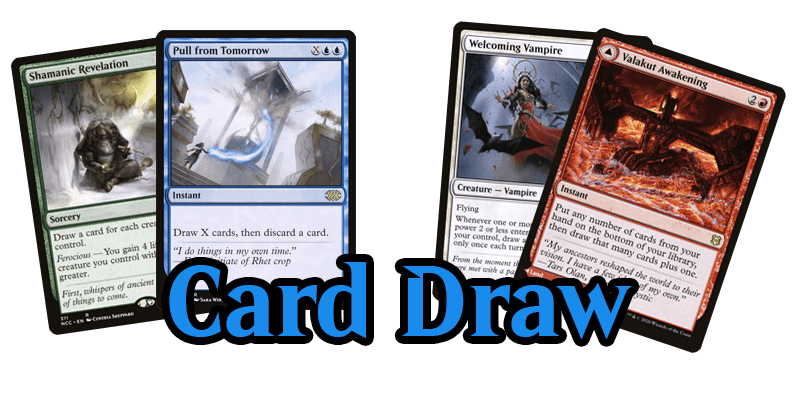
Another key aspect on how to make good commander decks is including card draw. You want to keep your hand filled as much as possible so you never run out of things to do. Being able to draw cards, especially when you are Hellbent (zero cards in hand) is very important. Kinda like being stuck on two lands mentioned above, it is not much fun having nothing to play because you’ve ran out of cards in hand.
Colors and Card Draw
Blue is by far the easiest color for card draw. Black is also pretty good as well, with the drawback of usually having to pay life. White used to be really bad, but honestly, it is kinda good now. Red’s card draw is usually discard and draw or exile and being able to play from exile until the end of turn or the end of the next turn. Green is probably the weakest color when it comes to card draw nowadays. But, regardless of color, you do have options.
- White: Loran of the Third Path, Halo Fountain, Welcoming Vampire, Spirited Companion, etc.
- Blue: Sea Gate Restoration, Rhystic Study (I mean, it has to be listed here), Pull From Tomorrow, Treasure Cruise, etc.
- Black: Phyrexian Arena, Deadly Dispute, Black Market Connections, Night’s Whisper, etc.
- Red: Valakut Awakening, Unexpected Windfall, Seize the Spotlight, Thrill of Possibility, etc.
- Green: Toski, Bearer of Secrets, Shamanic Revelation, Return of the Wildspeaker, Rishkar’s Expertise, etc.
- Colorless: Skullclamp, Ichor Wellspring, Mishra’s Bauble, Mask of Memory, etc.
Just a quick aside, Skullclamp is one of the most broken and powerful cards ever created. It is beyond powerful. If you play one, you love it. If an opponent plays one, you are miserable. It is basically in the ‘destroy on sight’ category of cards. You can also include Rhystic Study in that list too. This is a perfect example of why you want to run other types of removal on top of your creature removal.
My goal when I build a deck is to have a bare minimum of 7 card draw pieces. Ideally, you would include 8x – 11x pieces of card draw, as mentioned in the Commander Deck Building Template. It is very possible all of your card drawing is conditional and not automatic, unless you’re playing blue. A good amount of times, your card draw will be an ability of a creature, enchantment, artifact, land, etc.
Take Welcoming Vampire, for example. In order to get the card draw, you need a creature to enter the battlefield under your control whose power is 2 or less. Having a decent amount of card draw will also (hopefully) ensure you are able to not miss any land drops.
Knowing How to Build a Commander Deck Means Having Plenty of Lands
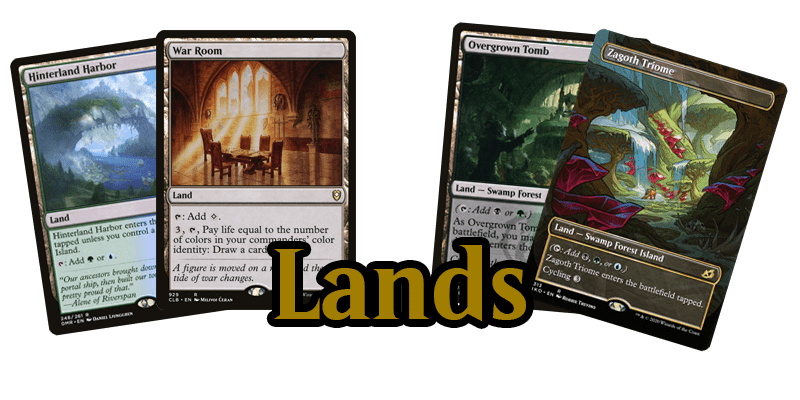
Lands play an import role in your deck. I know it is very tempting to cut a land from your deck and replace it with a cool new card that just came out. Don’t fall into this trap. You want to make sure that you are able to cast all of your spells, and cast them on time. When I first started playing, lands were the first thing I cut.
Heck, even my 60 card decks only ran like 20-22 lands while my Average Mana Value was like 3.75+. Not good. If you are prone to doing this, try and break the habit. There is nothing more boring and frustrating than playing Magic and being stuck on two lands.
I aim for 35x – 39x lands in my decks, based around the deck’s Average Mana Value and theme. If I am playing a Landfall deck, that number would be higher. That number includes all colored lands, utility lands, and multipurpose lands such as the MDFC Lands mentioned above. Some folks would even argue that this is too few lands to run.
If you’re one of those folks, by all means add more lands. But this is what I have found works for me. Again, this How to Build a Command Deck guide and the Commander Deck Building Template are by no means hard rules that must be followed.
To add a little context, I have a sea monster deck that runs 37 lands with an Average Mana Value of 4.81! It was one of the first commander decks I built and I haven’t touched it in a long time. I need to up the land count a bit if I ever want to play it again, since the Average Mana Value is so high.
Lands That Tap for Color
When creating your manabase, your first priority should be to make sure you have your colors. If you are running a mono-colored deck, that should be no problem. Just stick like 25 basics and the rest can be color-specific special lands and utility lands.
But once you start using two or more colors, you have to make sure you can get your colors. As stated above, if you have a multicolored deck that has green in it, my tip is to lean your manabase more towards green and use some of the spells found in The Best Green Ramp Spells guide to fix your colors.
If you don’t run green, you’ll want to make sure you have a variety of dual/tri lands that can get your colors. There are also some great lands that can create any color, both budget and non-budget.
I created a short and sweet guide on Tri Color Lands in MTG if you’re looking for some 3 color mana producers
Additionally, I also created an article that outlines 90+ different 5 Color Lands which is super helpful
Utility Lands
Depending on how many colors your deck runs will determine how many utility lands you should play. A mono-colored deck can play way more utility lands than a five colored deck. For a five colored deck, I would say four, at most utility lands. Even four might be pushing it. But a two colored deck? You could probably get away with five or six utility lands.
One utility land I always include in my decks, if my commander is three colors or less, is War Room. This might be one of my favorite utility lands ever. If my commander is four or five colors, and it is not light on creatures, I will play Bonder’s Enclave. If the conditions are met, both of these lands can be tapped and pay 3 generic mana to draw a card. Lands like this are a godsend if you are flooded.
You want your utility lands to come with added benefits. Usually they will only give you colorless mana, so that is why you don’t want to run a lot of them. Especially if you have more than two colors. Some of my other favorites are Reliquary Tower, Rogue’s Passage, Maze of Ith, Scavenger Grounds, etc. There are tons of other utility lands, so find some that have good synergy with you deck and deck’s theme.
Protection: Most Commander Deck Building Templates Don’t Mention this
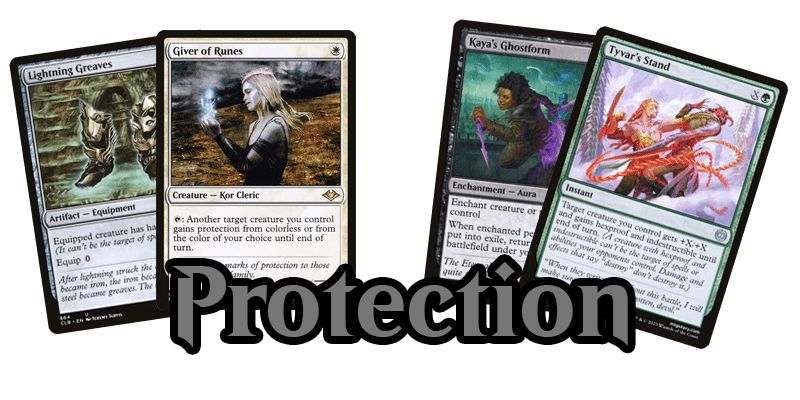
Something else you can do is ensure your valuable pieces stick around by protecting them. Nine times out of ten, your commander is the focal point of your deck. It feels pretty crummy to play your commander and an opponent removes it right away.
Sometimes, there is nothing you can do. Other times, you can (attempt) to protect it! As stated in the Commander Deck Building Template, you should aim to include 1x – 4x pieces of protection in your deck.
Protecting your permanents will come pretty easy with white and green. It can be a little unconventional in blue, black and red, however. For red, you can possibly rely on redirect spells, as mentioned in the Knowing How to Build a Commander Deck Will Require All Kinds of Removal section. Black will rely heavily on regenerating effects and blue will primarily rely on flicker or phasing effects.
Protection By Color
- White: Gods Willing, Shejiri Shelter, Giver of Runes, etc.
- Blue: Ghostly Flicker, March of Swirling Mist, Slip out the Back, etc.
- Black: Kaya’s Ghostform, Malakir Rebirth, Undying Malice, Feign Death, etc.
- Red: Deflecting Swat, Bolt Bend, Wyll’s Reversal, Wild Ricochet, etc.
- Green: Tyvar’s Stand, Tamiyo’s Safekeeping, Snakeskin Veil, etc.
Colorless Options
If you are looking for more options, especially in blue, black or red, there are a lot of colorless artifacts that can assist. The two most famous being Lightning Greaves and Swiftfoot Boots which will grant the creature they are attached to Shroud and Hexproof, respectively. There are many artifacts that can grant protection or indestructible, but here are some of the most commonly used ones:
A Good Commander Deck Has Lots of Synergy
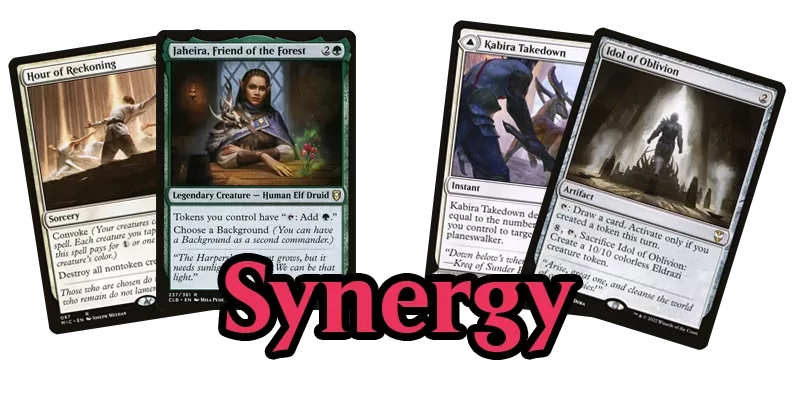
Once you have used the Commander Deck Building Template more and more and learned to master how to build a Commander deck, you will realize that your deck will begin to have a lot of synergy within itself. If you are not super comfortable with that just yet, you will want to identify what exactly your deck’s goal is before you begin building.
The majority of cards remaining in your deck should revolve around that theme or goal you’ve identified. This will give your spells more effectiveness and overall impact on the board.
Let’s create a hypothetical scenario to help illustrate the point of synergy and what is meant by it. We want to build a green/white Commander deck. The primary goal of this deck is to overwhelm the board with lots of tokens, enabling us to go wide and attack our opponents.
With our deck’s parameters defined and a clear goal, we can begin using the Commander deck building template to start adding in our pieces. But, we also want to find cards that work well with our deck’s theme.
Multipurpose Creature/Ramp
A good ramp spell for a green and white token deck could be including a copy of Jaheira, Friend of the Forest which lets each token creature tap for green mana. Not only is this a creature spell and a body on our board, it allows tokens to be mana producers. So in essence, Jaheira is treated both as a theme spell and a ramp spell, while only being 1 card out of the 99 rather than being 2 cards.
Synergistic Removal
Continuing with the token deck example, if you need a boardwipe, Hour of Reckoning would be a much better choice than say Wrath of God in our hypothetical deck. To start, chances are you will not be paying Hour of Reckoning‘s full casting cost since it has Convoke. Additionally, it is essentially a one-sided boardwipe, in our favor since our primary goal is to have a lot of tokens.
Your opponents will lose most, if not all of their creatures while you get to keep all of your tokens! Depending on how wide and large your tokens are, this could easily end the game by attacking all out, with your opponents not having any blockers remaining.
Synergistic Card Draw
In regards to card draw and synergy with the token deck example, Idol of Oblivion would be a really good inclusion. Since the deck is built around making tokens, you’ll essentially be able to draw an extra card every turn. It also has a bonus ability to create a 10/10 creature token, should you need it.
Multipurpose Removal/Land
A great piece of removal to include in our deck could be Kabira Takedown. With a token generating deck, we should have no problems having 5-10, or even more creatures on the battlefield. If this is in your hand early in the game and you need a land drop, play it on its reverse side as land. Kabira Takedown counts as both a land and removal, just like Jaheira, Friend of the Forest being multipurpose, as mentioned above.
Final Thoughts
I am not a professional player or even an expert. I just play for fun with some buddies most of the time. These are just some of the things I have picked up along the way that have worked for me. By using the Commander Deck Building Template fully, or even just as a starting point, you should have no problems learning how to build a Commander deck.
If you implement some of these ideas, your commander decks should run a bit more efficiently. Ramp so you can play bigger spells or multiple spells per turn faster. Have answers to opponent’s threats with removal. Keep drawing cards so you always have something to play. Make sure you have enough lands and some utility lands to assist you. And finally, having a lot of good synergy with your deck’s theme.
Let me know in the comments what your thoughts are on this How to Build a Commander Deck guide. I’d love other’s opinions on the Commander Deck Building Template as well. In Commander, there is always room for improvement and fine-tuning. I hope this guide and free template have helped you in some way. Now go and build yourself an awesome Commander deck!
You May Also Enjoy

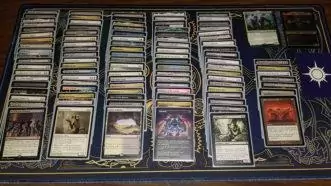
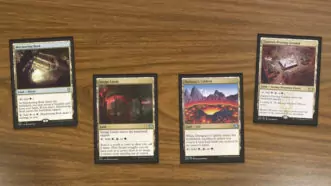
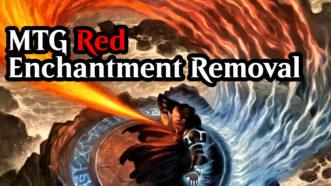
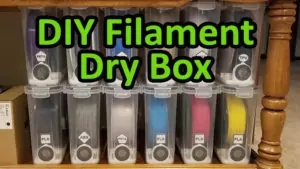

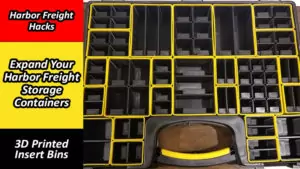
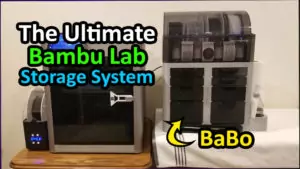

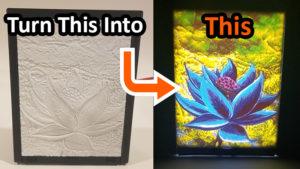
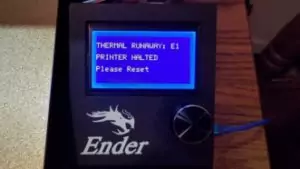
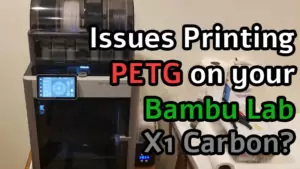

Leave a Reply